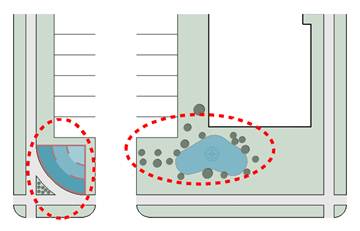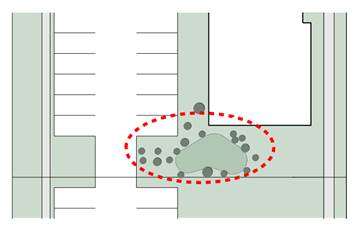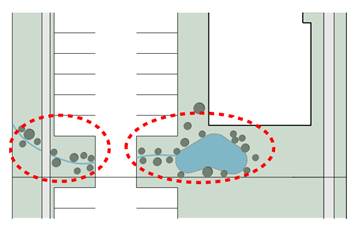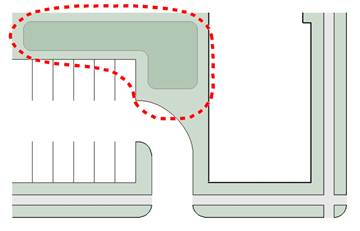18.15.120 Site Design Category 4
Site Design Category 4 provides standards to ensure compatible site development in areas designated by PlanOlathe as Commercial Corridors, Community Commercial Centers and Regional Commercial Centers. The following site design standards apply to all projects in Site Design Category 4. The letters illustrated in Figure 1 below correspond with the site design standards provided within this section.
Figure 1: Site Design Category 4
A. Outdoor Amenity Space Options
Development in Site Design Category 4 that is greater than four (4) acres in size or includes more than sixty-five (65) percent open space must include outdoor amenity space to enhance the public realm and promote pedestrian activity. Select one (1) or more of the following methods to cover at least ten (10) percent of the site area:
1. Plaza or Courtyard
A common use area directly accessible from adjoining buildings that includes decorative paving, street furniture, planters and/or pergolas.
2. Common Area
A common green space shared by users of the development that may include a lawn, a stand of trees, or shrubs.
3. Water Feature
A fountain or decorative pool shared by users of the development (note that properly designed artificial drainage areas may also be used to meet common open space standards).
4. Natural Feature
Stands of mature trees or natural drainage areas retained as an amenity for users of the development.
B. Parking Pod Size
The maximum number of parking stalls allowed in one (1) parking pod, as illustrated in Figure 1 of this section, is eighty (80).
C. Pedestrian Connection Options
Development in Site Design Category 4 must provide pedestrian connections from surrounding development, parking and adjacent transit stops, using at least one (1) of the following methods:
1. Pedestrian Gateway
Provide at least one (1) defined pedestrian gateway into the site using landscape and hardscape materials.
2. Cross Property Connection
Provide at least one (1) dedicated pedestrian connection across the development defined with wide sidewalks, special paving material or landscaping.
3. Pedestrian Connection to Adjacent Development
Provide at least one (1) dedicated off-street pedestrian and bicycle connection to an adjacent residential, commercial or mixed-use development, or to an adjacent transit stop.
4. Pedestrian Connection to Regional Trail
Provide at least one (1) dedicated pedestrian and bicycle connection to an adjacent pedestrian or multi-use trail.
D. Connectivity to Adjacent Driveways
Connections to driveways on adjacent properties are required where possible.
E. Distance between Curb Cuts
For the minimum distance between curb cuts, refer to the City’s Access Management Plan.
F. Drainage Features
Open drainage and detention areas visible to the public must be incorporated into the design of the site as an attractive amenity or focal point, using at least one (1) of the following methods:
1. Pond or Fountain
A wet-bottom basin in a prominent location that is enhanced with decorative features such as fountains, waterfalls, and/or extensive landscaping.

2. Landscaped Basin or Channel
A dry-bottom basin or channel that is maintained as extensively landscaped open space or yard area, designed with shallow slopes and a curvilinear, nongeometric shape to avoid an artificial appearance.

3. Natural Drainage Feature
Preservation of natural drainage areas including existing trees and vegetation. If existing trees and vegetation are missing or removed, new trees, shrubs, and plants should be added to restore the appearance of natural landscaping.

4. Geometric Basin
Artificial geometrically shaped basins should generally be avoided, but may be used in areas that are not visible to the public or from adjacent property.

G. Landscaped Buffer Area
Buffer standards apply to development in Site Design Category 4 when located adjacent to a residential zoning district. Standards are intended to mitigate visual and noise impacts on surrounding land uses.
1. Increased Setback
Buildings must be set back at least 40 feet from an adjoining R-1 or R-2 zoning district or designated open space.
2. Perimeter Landscaping
One (1) of the following landscaping strategies must be used within the required minimum setback area on the edges of a commercial site that directly abuts an R-1 or R-2 zoning district or designated open space:
a. Planted Buffer with No Fence or Wall
A landscaped area at the sidewalk edge that is at least forty (40) feet deep with a minimum of seventy (70) percent porous/permeable surfaces and fifty (50) percent planted material.
b. Planted Buffer with a Fence or Wall
A landscaped area of at least fifteen (15) feet between the sidewalk edge and a fence or wall with a minimum of seventy (70) percent porous/permeable surfaces and fifty (50) percent planted material. A fence or wall must be located within the landscape area and must include posts, columns, and/or pedestrian gateways a minimum of every one hundred (100) feet (⇔ See Section 18.50.050 for fence height and design). (Ord. 19-63 § 16, 2019; Ord. 15-16 § 3, 2015)